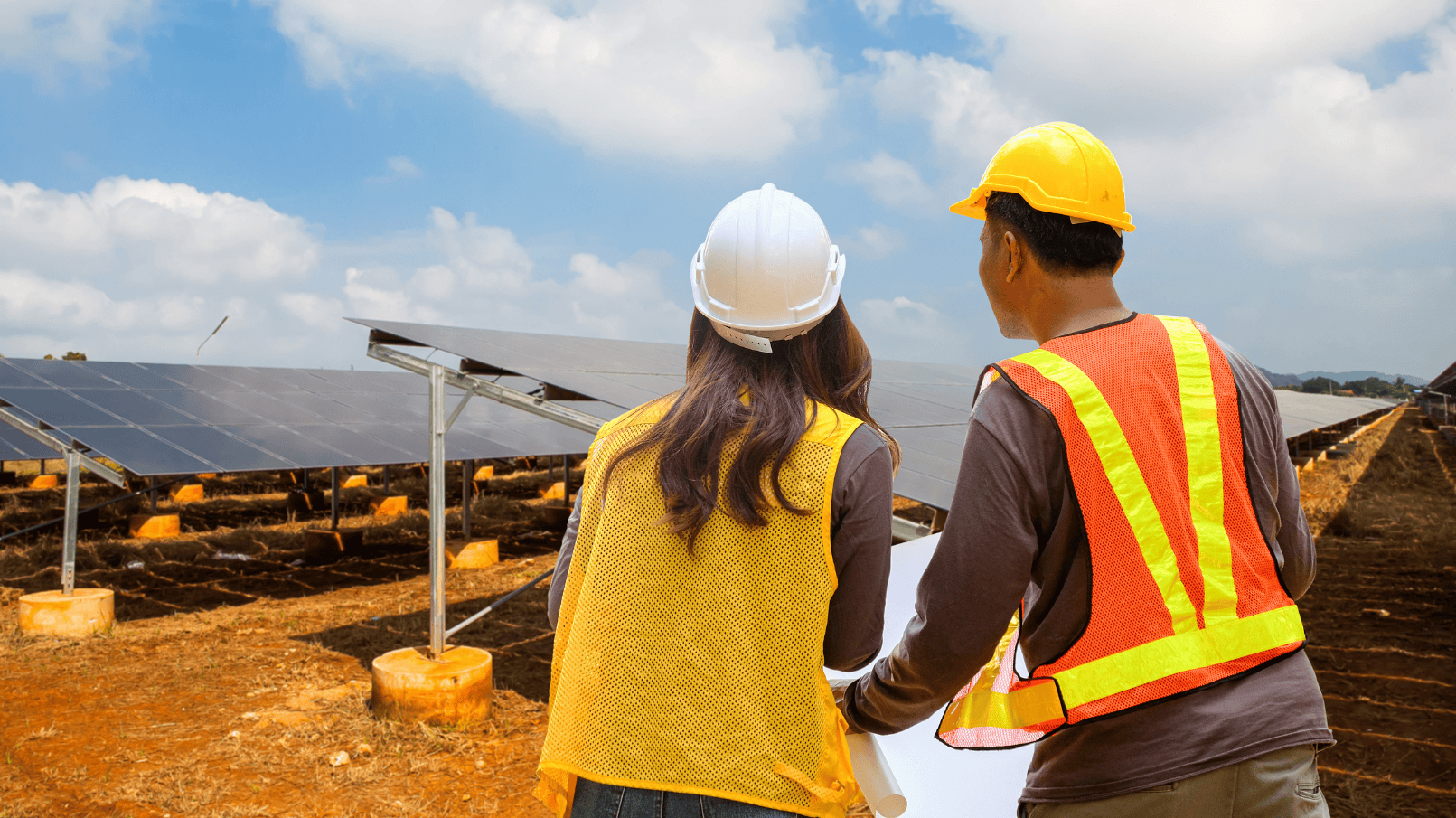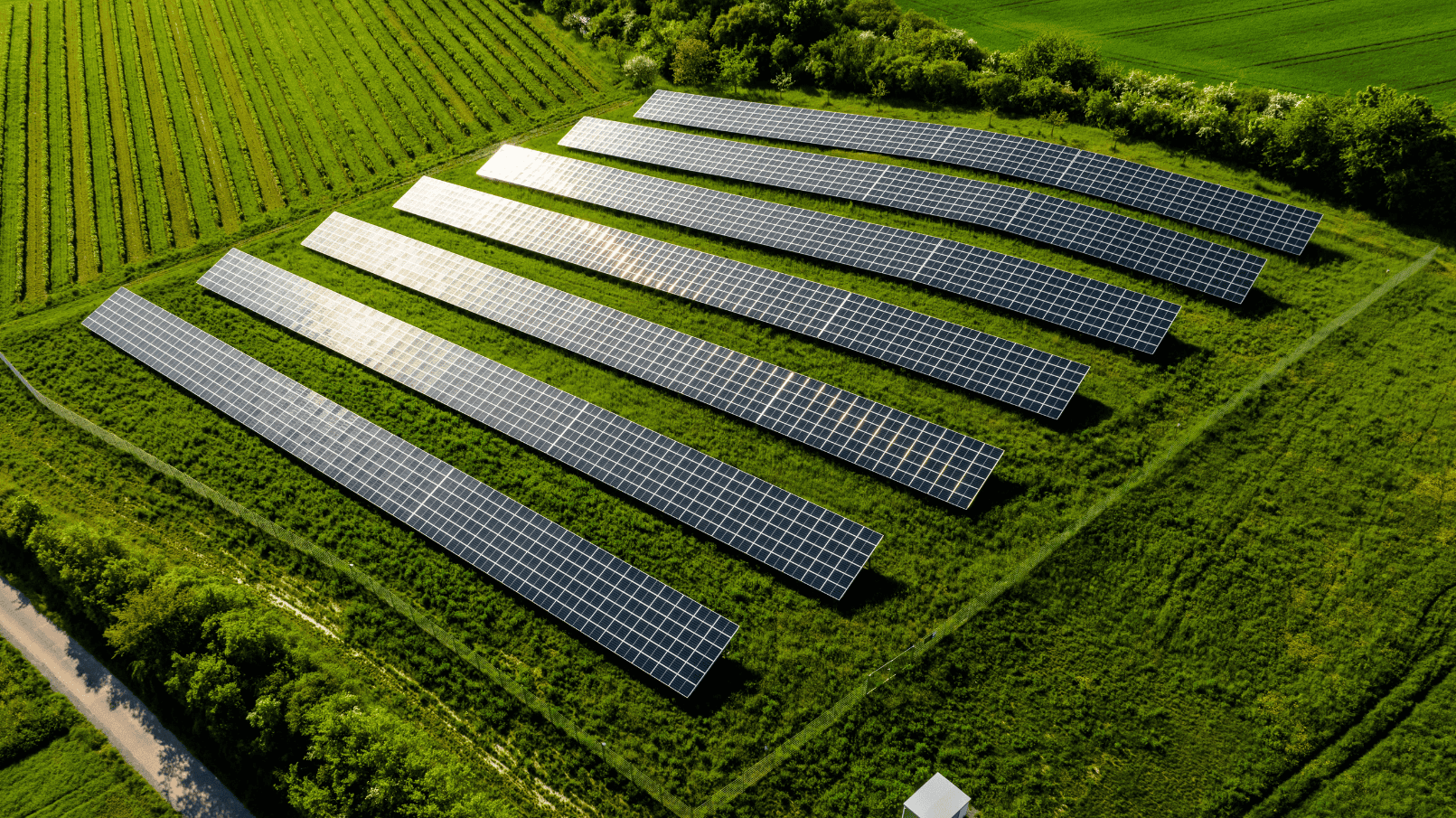Solar land leases are agreements between landowners and solar developers that allow developers to install solar panels on the property in exchange for a monthly lease payment. There are many benefits of entering into a solar land lease for landowners including long-term, monthly recurring revenue, a chance to participate in renewable energy generation, and minimal involvement and land impact.
This article outlines the practice of a solar land lease, its benefits, land qualification requirements, risks, and the future of land lease opportunities for solar projects. For more information on how to generate revenue from your vacant land, read on.
What Is A Solar Land Lease
A solar land lease is a mutually beneficial lease agreement between a landowner and a solar developer. Under this arrangement, the landowner allows the developer to install and operate a solar energy system, such as a solar farm, on their property. In return, the landowner earns regular lease payments, turning unused or underutilized land into a steady income source. While these agreements can be structured in different ways, a standard solar lease requires the developer to assume all project risk, maintain the land around the solar project, and make timely payments to the landowner.
Why Would A Landowner Want to Lease Their Land For Solar?
Leasing unused land for solar projects offers landowners a unique opportunity to turn their property into a significant income stream. Beyond financial benefits alone, this arrangement also allows landowners to contribute to the clean energy movement with minimal effort. Here are some key advantages:
- Long-term, recurring revenue, typically lasting 20-30 years.
- Minimal effort is required by the landowner.
- The land around the solar site is maintained by the solar developer.
- Allows landowners to support local, green energy generation that can be used in community solar projects or for local businesses.
- Landowners can monetize underutilized land that is not currently producing any income or additional benefit.
- Potential tax incentives are available for the landowner depending on the terms of the solar land lease agreement.
- Solar farm projects have a minimal impact on the land and can be quickly disassembled after the lease agreement ends.
- Solar land lease agreements increase the value of the land for a potential future sale.
Solar Land Lease Rates Per Acre
Standard solar land lease agreements offer landowners between $1,000 to $5,000 per acre depending on several factors such as topography, proximity to three-phase power, local solar policy, interconnection availability, and land condition. In solar-friendly states such as New Jersey, landowners can get top dollar for strategically positioned land parcels. In states where solar is still gaining momentum, these land lease rates can fall on the lower end of the scale.
Nevertheless, these agreements are attractive to landowners looking to supplement income, generate revenue from land that cannot be developed, or participate in the green energy transition.
Requirements And Land Suitability Criteria
In order to maximize your earning potential for leased land, there are several solar requirements that make your land more attractive. Let’s explore some of the land suitability criteria in more detail:
1. Grid Availability
First and foremost, the land must be located near a point on the electric grid that has the capacity for solar generation. Due to the recent boom in solar development, many locations on the power grid have excess solar generation. Grid operators are responsible for managing renewable energy output at each node on the power system to ensure that supply and demand are in continual balance. In some locations with too many solar projects, grid operators will not approve new systems to be installed and interconnected. A land parcel that is ideal for a solar land lease is located in an area that has vacancies for new solar projects.
2. Proximity To Three-Phase Power
Another key requirement for suitable solar development is for the land to be located near a three-phase power substation. Three-phase power is a sophisticated AC circuit made up of three wires. Connecting solar generation via three-phase power allows the system to be more efficient and integrate seamlessly into the power grid. Because solar projects must be connected to three-phase power, it is imperative that these access points are within a few miles of the solar system for the land to qualify.
3. Land Condition & Topography
When evaluating whether your land is suitable for solar development, understanding its terrain and topography is critical. Factors like flatness, slopes, obstructions, rocky areas, marshy areas, or bodies of water can influence the complexity of construction. While some of these features may present challenges, they aren’t always deal breakers. Assessing how the landscape could impact a potential solar project’s costs is an essential step in determining the feasibility of a solar project and a solar land lease.
4. Land Parcel Size
For a solar lease, the size of the land is a critical factor, with most projects requiring a minimum of 10-30 contiguous acres. Contiguous land ensures enough space for efficient solar panel installation and access for construction and maintenance. Larger parcels may also increase the potential energy output, making the property more attractive to developers.
5. Local Solar Policy
Favorable local solar policies are essential for ensuring smooth permit approvals during the development process. Areas with clear regulations and supportive policies reduce delays and make the land more attractive for solar projects and land leases. Landowners should review local guidelines to confirm that their property aligns with the requirements for solar development prior to seeking out a land lease.
6. Land Zoning
Local zoning plays a pivotal role in determining if a solar farm project can be approved. Some townships may restrict solar installations in areas visible to the public, citing aesthetic concerns. Land located away from public view or in industrially zoned areas is often better suited for solar development.
7. Sun Exposure
Optimal sun exposure is a key factor for solar farm success, as shading from trees or structures can reduce energy production. Ideal properties have minimal obstructions and receive consistent sunlight throughout the day. Enhancing sun exposure by cutting down trees and brush can significantly improve the land’s suitability for solar development.
8. Road Access
Easy road access is critical for solar developers to transport materials and equipment to the site during construction and maintenance. If roads need to be built, it can increase costs and reduce the overall value of the land lease. Properties with existing, accessible roads are far more appealing for solar projects.
My Land Qualifies – Now What?
If your land qualifies for a solar lease, Genie Solar Energy follows a detailed protocol that is designed to ensure a smooth and efficient development process. From initial consultation to construction and interconnection, we manage each phase of the project. Here’s what you can expect as we turn your land into a thriving solar project:
1. Initial Consultation
The process begins with a consultation meeting with Genie Solar Energy to discuss your land and its potential. During this consultation, we’ll do a preliminary evaluation of your land, outline the steps ahead, and address any questions or concerns you may have.
2. Site Evaluation
Next, our team will conduct a detailed, on-site analysis of your land’s characteristics, including its terrain, sun exposure, and proximity to power infrastructure. We will also check on local zoning laws, permit approval processes, and interconnection cues at the nearest substation. This evaluation confirms the land’s viability and helps identify the value of your land for a solar development.
3. Lease Proposal & Signing
Once your land is deemed suitable, we’ll propose and finalize a lease agreement with clear and transparent terms. This step ensures that all expectations, responsibilities, and financial details are outlined for both parties.
4. Project Planning & Permitting
Next, Genie Solar Energy manages all aspects of project planning, including engineering designs, obtaining necessary permits and approvals, and arranging for the procurement of solar panels and other construction materials. During this stage, we will also file an interconnection application proposing the project for integration into the local power grid. This stage is critical for ensuring compliance with zoning and regulatory requirements, setting the foundation for successful construction.
5. Construction & Interconnection
With permits and interconnection approvals in hand, we’ll begin constructing the solar farm, which typically takes several months depending on the project size. Once construction is complete, the system will be prepared for connection to the power grid, allowing energy production to begin.
6. Testing & Commissioning
This phase involves both cold and hot commissioning. During cold commissioning, our team will test the system before it is connected to the grid to ensure it is installed correctly. After cold commissioning is passed, we will turn the system live and test it once more after it is producing power.
7. Timeline Expectations
From initial consultation to the completion of construction, the entire process usually takes 18–24 months. Genie Solar Energy is committed to keeping you informed every step of the way, ensuring a seamless and rewarding experience.
FAQs:
Genie Solar Energy evaluates land based on size, sun exposure, zoning, and accessibility to three-phase power to determine land suitability.
The process involves consultation, site evaluation, site control agreement, and land lease agreement.
Landowners typically earn between $1,000 and $5,000 per acre annually, depending on the location and project details.
Solar leases often range from 20 to 30 years, with potential renewal options.
Yes, the lease allows Genie Solar, the solar developer, to use your land, but site ownership remains with you throughout the entire lease.
Ready To Get Started?
With years of experience and a strong reputation in the solar industry, Genie Solar Energy is your trusted partner for transforming unused land into a sustainable and profitable asset. Our team brings a proven track record of delivering successful solar projects with transparent processes and unmatched expertise. From initial consultation to long-term project management, we provide end-to-end support to ensure a seamless experience for landowners. By partnering with Genie, you gain a reliable partner dedicated to maximizing the value of your land while contributing to the renewable energy movement.
Ready to explore the potential of your land for solar development? Contact our team today for a free land assessment.

















